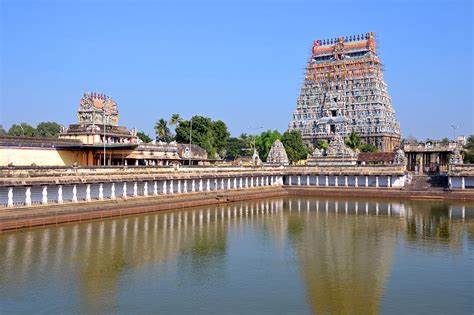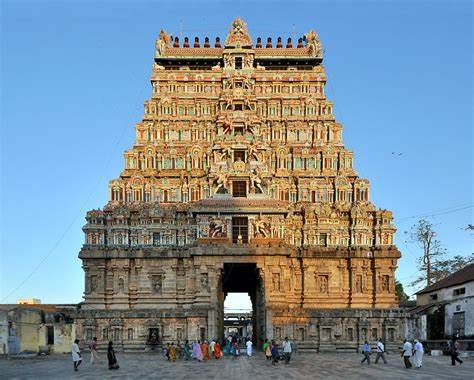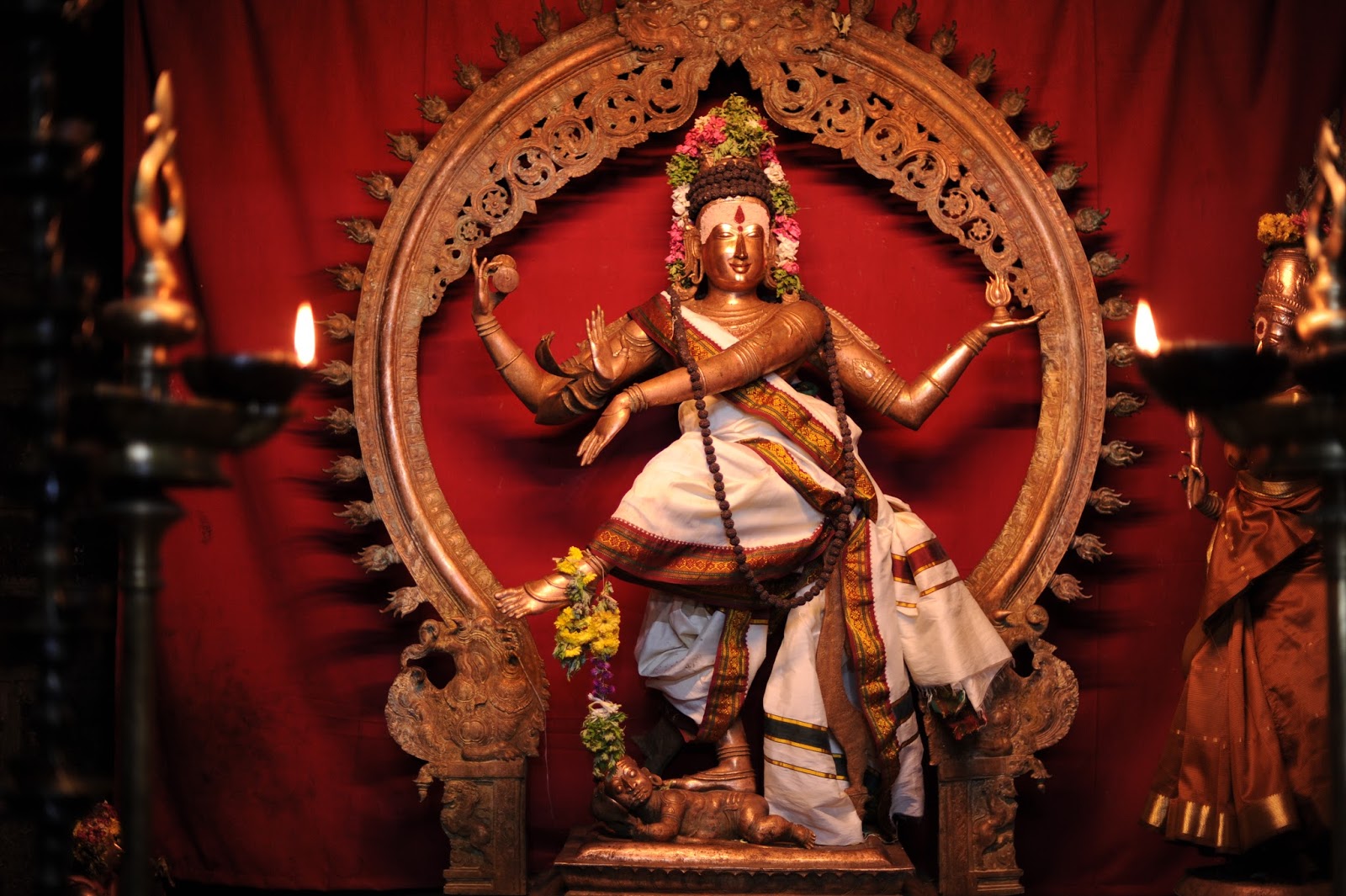
Thillai Nataraja Temple, Chidambaram, Tamil Nadu
This is a Hindu temple dedicated to Nataraja, the dancing form of Lord Shiva. It is located in the town of Chidambaram in the Cuddalore district of the Indian state of Tamil Nadu. The temple is one of the five Pancha Bootha Sthalams, representing the element of space. The temple has ancient roots and a Shiva shrine existed at the site when the town was known as Thillai. Chidambaram, the name of the city literally means “stage of consciousness”. The temple architecture symbolizes the connection between the arts and spirituality, creative activity and the divine.The temple is a vast complex with five gopurams (gateway towers) and several mandapams (halls). The main sanctum sanctorum houses the image of Nataraja, which is made of panchaloha (five metals). The image is depicted in the cosmic dance pose, with one foot raised and the other resting on a demon. The dance is said to represent the cycle of creation, destruction and preservation.
Historical background and Architectural splendor
The temple’s origins remain shrouded in some mystery, but historical evidence suggests a Shiva shrine existed at the site well before the 7th century AD. References appear in ancient Tamil literature, and inscriptions from the Chola dynasty (9th-13th centuries) mention the temple’s grandeur.
The temple has witnessed a tumultuous past. Throughout history, it has been under the patronage of various dynasties – the Pallavas, Cholas, Pandyas, and the Vijayanagara Empire – each contributing to its expansion and embellishment. It also faced periods of neglect and destruction, particularly during invasions by the Delhi Sultanate.Thillai Nataraja Temple has been a prominent center of Tamil Shaivism and a pilgrimage site for centuries. It is considered one of the five Pancha Bootha Sthalams, representing the element of “space” within the cosmic framework.
The temple is a sprawling complex enclosed by high walls. Five towering gopurams (gateway towers) mark the cardinal directions, each adorned with intricate sculptures depicting deities and stories from Hindu mythology.
Within the complex, numerous mandapams (halls) serve diverse purposes. Some, like the Aayiram Kaal Mandapam (Thousand Pillared Hall), showcase architectural prowess with intricate pillars and carvings. Others, like the Kanaka Sabha (Golden Hall), house valuable artworks and sculptures.
The heart of the temple is the sanctum sanctorum, housing the revered bronze statue of Nataraja, the dancing form of Lord Shiva. Made of panchaloha (five metals), the statue is a masterpiece of artistry, capturing the dynamic posture and symbolic gestures of the cosmic dance.The temple’s architecture itself is imbued with symbolic meaning. The five gopurams represent the five senses, while the sanctum sanctorum signifies the ultimate reality beyond the senses. The dancing Nataraja embodies the eternal cycle of creation, preservation, and destruction.

Religious Significance
This temple holds immense religious significance as one of the most venerated Shaivite shrines in India. Dedicated to Lord Nataraja, the cosmic dancer form of Lord Shiva, the temple is renowned for its ancient roots and spiritual symbolism. The presiding deity, Nataraja, is depicted in the Ananda Tandava posture, symbolizing the cosmic dance that represents the rhythmic cycles of creation, preservation, and destruction. The temple's architectural splendor, with intricately carved sculptures and the renowned "Chidambaram Rahasya," contributes to its spiritual allure.

Festival and Celebrations
Here the festivals celebrated are Maha Shivaratri, Aani Thirumanjanam, Arudra Darshan, Thai Poosam, Panguni Uthiram and Navaratri.
Surroundings area & attractions
- Bhuvanagiri Amman Temple: Situated in nearby Bhuvanagiri, this ancient temple dedicated to Goddess Bhuvaneshwari attracts devotees with its architectural beauty and religious significance. The temple is located atop a small hill, offering panoramic views of the surrounding countryside.
- Tiruvetkalam Temple: This ancient temple, dedicated to Lord Shiva, is located about 6 kilometers from Chidambaram. It is believed to be one of the nine Navagraha temples in Tamil Nadu, associated with the planet Mars (Angaraka).
- Thillai Kali Temple: Located within the premises of the Thillai Nataraja Temple complex, the Thillai Kali Temple is dedicated to Goddess Kali. Devotees visit this temple to seek blessings for protection and prosperity.
FAQ
The Thillai Nataraja Temple is dedicated to Lord Nataraja, the cosmic dancer form of Lord Shiva. It is considered one of the holiest Shiva temples in South India and holds immense religious and cultural significance.
The exact date of the temple’s construction is uncertain, but it is believed to have ancient origins dating back over a thousand years. The temple has undergone renovations and expansions over the centuries, with contributions from various dynasties.
Some of the main festivals celebrated at the temple include Maha Shivaratri, Arudra Darshan, Aani Thirumanjanam, Thai Poosam, Panguni Uthiram, and Navaratri.
There is no entry fee to visit the temple.
Visitors are expected to dress modestly and respectfully when visiting the temple.
Photography and videography may be allowed in certain areas of the temple complex.
The temple is easily accessible by road, rail, and air. Chidambaram Railway Station is the nearest railhead, and Tiruchirappalli International Airport is the nearest airport.
Yes, guided tours may be available for visitors who wish to learn more about the temple’s history, mythology, and architectural features.
The temple is open to visitors from early morning until late evening.
Yes, there are several accommodation options available near the Thillai Nataraja Temple to suit various budgets and preferences.
Yes, the temple authorities may allow devotees to perform special pujas or rituals under certain conditions.
Yes, visitors are expected to follow certain protocols and etiquette when visiting the temple.
The temple provide facilities which include wheelchair access, designated seating areas, and assistance from temple volunteers to accommodate senior citizens and differently-abled visitors.
Chidambaram town has several eateries, restaurants, and roadside stalls where visitors can enjoy traditional South Indian cuisine and other delicacies.
Visitor information
Entry Fee: No fee
Timings :
- 6:00 AM -10:00 PM
Darshan Days- All Days
Address:
Thillai Nataraja Temple, East Car Street, Chidambaram, Tamil Nadu 608001, India.
Notable Events and Incidents
- Construction of Thillai Nataraja Temple in Chidambaram initiated 1589.
- The temple faced destruction during the Carnatic Wars in 1740.
- The Chidambaram Rahasya, the secret behind the deity's formless space, was revealed to the public in 1951.
- The temple underwent extensive renovations to preserve its architectural grandeur in 1981.
- UNESCO recognized the temple as a part of the "Great Living Chola Temples" as a World Heritage Site in 2005.
- The Natyanjali Dance Festival celebrated its 38th edition, showcasing classical dance forms in devotion to Lord Nataraja in 2019.
Connectivity :
- Road: Chidambaram is well-connected by road to major cities and towns in Tamil Nadu and neighboring states.
- Rail: Chidambaram Railway Station is an important railhead in Tamil Nadu and is served by regular train services connecting it to major cities like Chennai, Coimbatore, Madurai, Tiruchirappalli, and others.
- Air: The nearest airport to Chidambaram is Tiruchirappalli International Airport (TRZ), located approximately 185 kilometers away.
